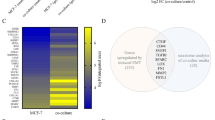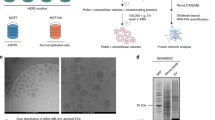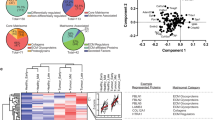Abstract
Tumor–stroma interactions play a major role in tumor development, maintenance and progression. Yet little is known on how the genetic alterations that underlie cell transformation elicit cell extrinsic changes modulating heterotypic cell interactions. We hypothesized that these events involve a modification in the complement of secreted proteins by the cell, acting as mediators of intercellular communication. To test this hypothesis, we examined the role of wt-p53, a major tumor suppressor, on the tumor microenvironment through its regulation of secreted factors. Using a combination of 2-DE and cICAT proteomic techniques, we found a total of 111 secreted proteins, 39 of which showed enhanced and 21 inhibited secretion in response to wt-p53 expression. The majority of these were not direct targets of p53 transcription factor activity, suggesting a novel role for wt-p53 in the control of intracellular protein trafficking and/or secreted protein stability. Evidence for p53-controlled post-translational modifications on nine secreted proteins was also found. These findings will enhance our understanding of wt-p53 modulated interactions of the tumor with its environment.
This is a preview of subscription content, access via your institution
Access options
Subscribe to this journal
Receive 50 print issues and online access
$259.00 per year
only $5.18 per issue
Buy this article
- Purchase on Springer Link
- Instant access to full article PDF
Prices may be subject to local taxes which are calculated during checkout




Similar content being viewed by others
Accession codes
Accessions
GenBank/EMBL/DDBJ
Abbreviations
- β-2M:
-
beta-2-microglobulin
- 2-DE:
-
two-dimensional gel electrophoresis
- cICAT, cleavable isotope-coded affinity tag technology; CM:
-
conditioned media
- ECM:
-
extracellular matrix
- FGF-4:
-
fibroblast growth factor-4
- Gal-1:
-
Galectin-1
- Gal-3:
-
galectin-3
- Pre-alb:
-
pre-albumin
- SPARC:
-
secreted protein with acidic and cysteine-rich domains
- TGF-β:
-
transforming growth factor beta
- TSP1:
-
thrombospondin-1
References
Albertoni MD, Daub M, Arden KC, Viars CS, Powell C, Van Meir EG . (1998). Genetic instability leads to loss of both p53 alleles in a human glioblastoma. Oncogene 16: 321–326.
Albertoni M, Shaw PH, Nozaki M, Godard S, Tenan M, Hamou M-F et al. (2002). Anoxia induces macrophage inhibitory cytokine-1 (MIC-1) in glioblastoma cells independently of p53 and HIF-1. Oncogene 21: 4212–4219.
Amzallag N, Passer BJ, Allanic D, Segura E, Thery C, Goud B et al. (2004). TSAP6 facilitates the secretion of translationally controlled tumor protein/histamine-releasing factor via a nonclassical pathway. J Biol Chem 279: 46104–46112.
Babic AM, Kireeva ML, Kolesnikova TV, Lau LF . (1998). CYR61, a product of a growth factor-inducible immediate early gene, promotes angiogenesis and tumor growth. Proc Natl Acad Sci USA 95: 6355–6360.
Bhowmick NA, Moses HL . (2005). Tumor–stroma interactions. Curr Opin Genet Dev 15: 97–101.
Brat DJ, Bellail AC, Van Meir EG . (2005). The role of interleukin-8 and its receptors in gliomagenesis and tumoral angiogenesis. Neuro-oncol 7: 122–133.
Bueter M, Gasser M, Lebedeva T, Benichou G, Waaga-Gasser AM . (2006). Influence of p53 on anti-tumor immunity (review). Int J Oncol 28: 519–525.
Chiarugi V, Magnelli L, Gallo O . (1998). Cox-2, iNOS and p53 as play-makers of tumor angiogenesis (review). Int J Mol Med 2: 715–719.
Desbaillets I, Diserens AC, Tribolet N, Hamou MF, Van Meir EG . (1997). Upregulation of interleukin 8 by oxygen-deprived cells in glioblastoma suggests a role in leukocyte activation, chemotaxis, and angiogenesis. J Exp Med 186: 1201–1212.
Framson PE, Sage EH . (2004). SPARC and tumor growth: where the seed meets the soil? J Cell Biochem 92: 679–690.
Fulci G, Van Meir EG . (1999). p53 and the CNS: tumors and developmental abnormalities. Mol Neurobiol 19: 61–77.
Goldman D, Merril CR, Ebert MH . (1980). Two-dimensional gel electrophoresis of cerebrospinal fluid proteins. Clin Chem 26: 1317–1322.
Görg A, Weiss W, Dunn MJ . (2004). Current two-dimensional electrophoresis technology for proteomics. Proteomics 4: 3665–3685.
Gygi SP, Rist B, Griffin TJ, Eng J, Aebersold R . (2002). Proteome analysis of low-abundance proteins using multidimensional chromatography and isotope-coded affinity tags. J Proteome Res 1: 47–54.
Hanahan D, Weinberg RA . (2000). The hallmarks of cancer. Cell 100: 57–70.
Harris SL, Levine AJ . (2005). The p53 pathway: positive and negative feedback loops. Oncogene 24: 2899–2908.
Kamemura K, Hart GW . (2003). Dynamic interplay between O-glycosylation and O-phosphorylation of nucleocytoplasmic proteins: a new paradigm for metabolic control of signal transduction and transcription. Prog Nucleic Acid Res Mol Biol 73: 107–136.
Khwaja FW, Duke-Cohan JS, Brat DJ, Van Meir EG . (2006). Attractin is elevated in the cerebrospinal fluid (CSF) of patients with malignant astrocytoma and mediates glioma cell migration. Clinical Cancer Research, in press.
Lee R, Kermani P, Teng KK, Hempstead BL . (2001). Regulation of cell survival by secreted proneurotrophins. Science 294: 1945–1948.
Mazzocca A, Coppari R, De Franco R, Cho JY, Libermann TA, Pinzani M et al. (2005). A secreted form of ADAM9 promotes carcinoma invasion through tumor–stromal interactions. Cancer Res 65: 4728–4738.
Morimoto I, Sasaki Y, Ishida S, Imai K, Tokino T . (2002). Identification of the osteopontin gene as a direct target of TP53. Genes Chromosomes Cancer 33: 270–278.
Pietras K, Rubin K, Sjoblom T, Buchdunger E, Sjoquist M, Heldin CH et al. (2002). Inhibition of PDGF receptor signaling in tumor stroma enhances antitumor effect of chemotherapy. Cancer Res 62: 5476–5484.
Qin G, Kishore R, Dolan CM, Silver M, Wecker A, Luedemann CN et al. (2006). Cell cycle regulator E2F1 modulates angiogenesis via p53-dependent transcriptional control of VEGF. Proc Natl Acad Sci USA 103: 11015–11020.
Steele RJ, Lane DP . (2005). P53 in cancer: a paradigm for modern management of cancer. Surgeon 3: 197–205.
Stuelten CH, DaCosta Byfield S, Arany PR, Karpova TS, Stetler-Stevenson WG, Roberts AB . (2005). Breast cancer cells induce stromal fibroblasts to express MMP-9 via secretion of TNF-alpha and TGF-beta. J Cell Sci 118 (Part 10): 2143–2153.
Sun Y, Cheung JM, Martel-Pelletier J, Pelletier JP, Wenger L, Altman RD et al. (2000). Wild type and mutant p53 differentially regulate the gene expression of human collagenase-3 (hMMP-13). J Biol Chem 275: 11327–11332.
Taieb J, Chaput N, Menard C, Apetoh L, Ullrich E, Bonmort M et al. (2006). A novel dendritic cell subset involved in tumor immunosurveillance. Nat Med 12: 214–219.
Tenan M, Fulci G, Albertoni M, Diserens AC, Hamou MF, El Atifi-Borel M et al. (2000). Thrombospondin-1 is downregulated by anoxia and suppresses tumorigenicity of human glioblastoma cells. J Exp Med 191: 1789–1798.
Tsai MS, Hornby AE, Lakins J, Lupu R . (2000). Expression and function of CYR61, an angiogenic factor, in breast cancer cell lines and tumor biopsies. Cancer Res 60: 5603–5607.
Tsuzuki T, Izumoto S, Ohnishi T, Hiraga S, Arita N, Hayakawa T . (1998). Neural cell adhesion molecule L1 in gliomas: correlation with TGF-beta and p53. J Clin Pathol 51: 13–17.
Van Meir EG, Polverini PJ, Chazin VR, Su Huang HJ, de Tribolet N, Cavenee WK . (1994). Release of an inhibitor of angiogenesis upon induction of wild type p53 expression in glioblastoma cells. Nat Genet 8: 171–176.
Van Meir EG, Roemer K, Diserens A-C, Kikuchi T, Rempel SA, Haas M et al. (1995). Single-cell monitoring of growth arrest and morphological changes induced by transfer of wild type p53 alleles to glioblastoma cells. Proc Natl Acad Sci USA 92: 1008–1012.
Volmer MW, Stuhler K, Zapatka M, Schoneck A, Klein-Scory S, Schmiegel W et al. (2005). Differential proteome analysis of conditioned media to detect Smad4 regulated secreted biomarkers in colon cancer. Proteomics 5: 2587–2601.
Wang J, Shou J, Chen X . (2000). Dickkopf-1, an inhibitor of the Wnt signaling pathway, is induced by p53. Oncogene 19: 1843–1848.
Xie D, Yin D, Wang HJ, Liu GT, Elashoff R, Black K et al. (2004). Levels of expression of CYR61 and CTGF are prognostic for tumor progression and survival of individuals with gliomas. Clin Cancer Res 10: 2072–2081.
Yu X, Harris SL, Levine AJ . (2006). The regulation of exosome secretion: a novel function of the p53 protein. Cancer Res 66: 4795–4801.
Zigrino P, Loffek S, Mauch C . (2005). Tumor-stroma interactions: their role in the control of tumor cell invasion. Biochimie 87: 321–328.
Acknowledgements
We thank Drs JC Lucchesi, D Pallas, I Matsumura and P Vertino for their support. This work was supported by National Institutes of Health (NIH) grants CA 86335 (to EGVM); NCRR 02878, 12878, 13948 (to Microchemical and Proteomics Facility), the Pediatric Brain Tumor Foundation of the US (to EGVM) and the American Brain Tumor Association (to BP), the Genetics and Molecular Biology (GMB) program of the Graduate Division of Biological and Biomedical Sciences (GDBBS) of Emory University, and the National Science Foundation (NSF) (PRISM; DGE0231900).
Author information
Authors and Affiliations
Corresponding author
Additional information
FWK and EGVM designed and interpreted experiments and wrote the manuscript. FWK performed experiments with the help of PS, MR and JP for the MS analyses. BP performed the microarrays and Northern blot. All authors read the manuscript.
Rights and permissions
About this article
Cite this article
Khwaja, F., Svoboda, P., Reed, M. et al. Proteomic identification of the wt-p53-regulated tumor cell secretome. Oncogene 25, 7650–7661 (2006). https://doi.org/10.1038/sj.onc.1209969
Received:
Revised:
Accepted:
Published:
Issue Date:
DOI: https://doi.org/10.1038/sj.onc.1209969
Keywords
This article is cited by
-
Distinct mechanisms mediating therapy-induced cellular senescence in prostate cancer
Cell & Bioscience (2022)
-
Glioblastoma cells inhibit astrocytic p53-expression favoring cancer malignancy
Oncogenesis (2014)
-
E3 ubiquitin ligase TRIM32 negatively regulates tumor suppressor p53 to promote tumorigenesis
Cell Death & Differentiation (2014)
-
Attachment-regulated signaling networks in the fibroblast-populated 3D collagen matrix
Scientific Reports (2013)
-
SPARC functions as an anti-stress factor by inactivating p53 through Akt-mediated MDM2 phosphorylation to promote melanoma cell survival
Oncogene (2011)



